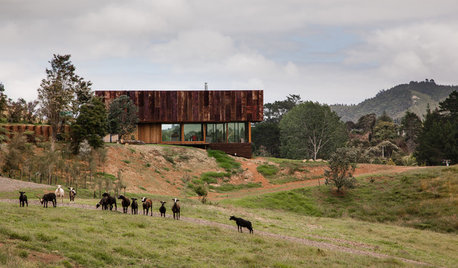Home made sausage
This is probably the wrong forum for this and I apologize if it is. We have just gotten involved in making sausage at home and the first batch was really good. Now, want to branch out and get into making more but still just for us and the family and stuffing in casings. So far, we are using the Kitchen Aid mixer with meat grinder attachment, but I think it is not the right machine for this other than just very casual. I am afraid we are going to overload and ruin the mixer.
If anyone on here makes your own sausage, please share with us your suggestions for meat grinder, stuffer, kind of casings and any sausage recipes. We have asked the butcher at Homeland to save us some pork fat, but it is really hard to come by to mix with the meat. We are using Pork Butt Shoulders for the meat and it is really great and reasonable to buy also.
Thanks, Bob and Pat (Goldsby Oklahoma)
Comments (150)
remy_gw
16 years agolast modified: 9 years agoHi,
I got the sausage book 'Great Sausage
Recipes and Meat Curing' from the place on the link below. I think it is a good book quite extensive in general info and recipes. I don't if it can be found for cheaper, I didn't do a search. There are also many other sausage products on his site. Again, because it is easy to just go there and buy stuff local, I don't know how prices compare to other web sites.
RemyHere is a link that might be useful: Sausage Maker Book
ksrogers
16 years agolast modified: 9 years agoI have posted the Sausage Maker site in several of my posts and linksinks, As well as Butcher Packer, and Allied Kenco. All these companies have an extensive array of meat curing supplies, sausage making supplies, and many mixes for a lot of different sausages. Where else can you find dried beer, or high melting point cheddar cheese already diced. Counting down to post #5 in this thread, you will see I mention the same companies I mention here. I guess no one seems to read much of my posts.
Related Professionals
West Milford Landscape Architects & Landscape Designers · Athens Landscape Contractors · East Lake-Orient Park Landscape Contractors · Eureka Landscape Contractors · Severna Park Landscape Contractors · South Lake Tahoe Landscape Contractors · Twin Falls Landscape Contractors · West Covina Landscape Contractors · Palos Hills Landscape Contractors · Elgin Roofing & Gutters · Staten Island Roofing & Gutters · Black Forest Roofing & Gutters · Canton Driveway Installation & Maintenance · Cleveland Driveway Installation & Maintenance · Greensboro Driveway Installation & Maintenancerunningtrails
16 years agolast modified: 9 years agoWell, here are some more ideas. Sausage is not the only thing you can use those machines and stuff the casings with. You can fill them with anything you want.
Suggestions to fill sausage casings:
1. Pizza or lasagna makings, ground
2. Chopped Cooked chicken and grilled peppers, onion, zucchini with zesty Italian dressing
3. Scrambled eggs with grilled onions, mushrooms and bacon bits
4. Creamy chicken in sause with grilled onions and peppers
5. Cheesy broccoli and chickentodd_ellis
16 years agolast modified: 9 years agohi - lots of good information here! maybe someone can help. i am looking for a recipe to grind my own apple (or apple-kraut) bratwurst ... i had it once - but now it's GONE! anybody???
thanks!
remy_gw
16 years agolast modified: 9 years agoKsrogers,
Lol, I read all the posts looking for mention of the book I have. I didn't notice you gave the web site address in one of the first posts! I do love to read you posts; you have tons of knowledge on this subject and many others! : )
Remybejay9_10
16 years agolast modified: 9 years agorunningtrails -
That's interesting. How do you use these sausage fillings then - in recipes - or just use them as storage containers - to freeze??
Bejay
ksrogers
16 years agolast modified: 9 years agoI would expect that an apple brat would use peeled and ground apples as well as cinnamon and maybe some cardamom. Beef and pork are the two meats usually used in most bratwurst. You may want to just try grinding these and then tasting once you are at a point when they are ready to stuff. Just make sure you spoon out a small portion to cook it before you taste it. Adding more apples, or other spices are easy to do, even after you cook up a small sample and find its not as flavored as you like. I would also add a bit of frozen apple juice, as there is always some water or other liquid added to most all sausages. Here, I cannot make a sausage without also adding a little phosphate to bind it together, as I hate dry crumbly sausages.
My meat grinder as a 'chub' insert that stuffs things inside or outside another item. Haven't used that yet, but it does look interesting.ksrogers
16 years agolast modified: 9 years agoA local, small supermarket near here (Johnnys') has a whole boneless beef tenderloin on sale for just $5.99 a pound. What a bargain! I bought two, will slice into some steaks and a small roast, then pack in Food Saver bags in the freezer. Great on the BBQ grill in the summer.
macheske
16 years agolast modified: 9 years agoDoes anyone have a recipe for the kind of hotdogs we used to get as kids? You remember them. They were crisp when you bit into them? I have found them in the local market but I hate paying $6-8 a pound for them! BTW...I tried using soy protien for the first time in my sausage last month. I wish I had tried it before. The sausage is very low in fat but the soy protein seems to hold it together and keep it juicy.
Thanks in advance.
Rickksrogers
16 years agolast modified: 9 years agoYes, soy will do that as will a little phosphate. Both act as a moisture retainer and a binder. For the franks, you can either use a sheep casing or the dried edible collegen casings in the diameters for franks. If you add too much soy, the franks will split open when cooked. Here are a few sources:
http://www.butcher-packer.com/pages-productinfo/product-261/21mm-clear-edible-collagen-casing.html
http://www.butcher-packer.com/pages-productinfo/product-308/casing-for-snacks-hot-dogs-22-24mm.html
http://www.alliedkenco.com/catalog/product_info.php/cPath/32_229/products_id/1234
Seasoning mixes:
http://www.alliedkenco.com/catalog/index.php/cPath/49_594_902
http://www.butcher-packer.com/pages-productinfo/product-373/bologna-frankfurter-seasoning.html
http://www.sausagemaker.com/index.asp?PageAction=VIEWPROD&ProdID=532Please keep in mind that all of these MUST be cooked after stuffing. When your preparing these for eating, they are just simply heated up or grilled. The texture of the filling has to be ground very fine and run through a heavy duty food processor if you want a smooth paste, as opposed to a chunky texture. If you like a bit of smoke, they could either be smoked naturally, or you add a bit of liquid smoke to the filling.
Imagine making home made turkey sausages, or all beef, or a mix of many meat types. Be sure to cook up a small spoonful and taste it before stuffing.macheske
16 years agolast modified: 9 years agoThanks for the info ksrogers! I put in an order to butcher-packer since I've ordered from them before and had good service.
ksrogers
16 years agolast modified: 9 years agoAll three companies mentioned, I have done business with and they are every good for getting unusual items for making unusual sausage types. My Canadian bacon can't be beat, and is about 1/4 the cost compared to store bought, same with pastrami.
ksrogers
16 years agolast modified: 9 years agoPicked up about 16 pounds of boneless pork shoulder at Costco. Plan to make a big huge batch of Polish Kielbasa tomorrow, loaded with Marjorum and garlic, plus a few other 'secret spices'.
Today, I got some cheap skinless boneless chicken breasts ($1.59/lb.) and pounded them out, spread Dijon mustard on them, and placed a chunk of Jarlsberg cheese and smoked ham. The outsides were coated with seasoned bread crumbs. I used the Foodsaver to seal each as individual meals that cook up in half an hour.
ksrogers
16 years agolast modified: 9 years agoAdded about 2 pounds of pork fat to the meat, as well as a LOT of garlic, fresh, jarred, and dried, some liquid hickory smoke, and marjorum, as well as chopped onions, and some ground up yellow mustard seeds. All this, along with a little water, some soy flour, and fat replacer, and the meat batch now weighs nearly 25 pounds. Cooked up a spoonful and it is perfect. I like using salt free sausage seasoning mixes as a base, then add the spices I like as well as the amount of salt I feel is sufficient. Its all mixed, and read to go in the stuffer tomorrow. I plan to use the motor unit I got recently, that attaches to the stuffer. The meat will go into hog casings.
Next come Perogies, onion, cheddar and bacon, and broccoli with cheese, and of course every batch will also have potatoes (red bliss) mashed.
arabid
16 years agolast modified: 9 years agoI enjoy all your postings and specially KSrogers' tips. I was wondering if anyone has tried making Spanish chorizo (not like Mexican chorizo which has vinegar). I've tries several internet recipes but they were all duds. Maybe one of you might be willing to share a tried and tested recipe for Spanish chorizo? Thanks!
ksrogers
16 years agolast modified: 9 years agoYou may want to try one of the sausage making sources I posted, as they do offer some mixes for them. I seem to recall that one mix had this, but as you say, they do call for vinegar. When I made a batch, I went a bit overboard on the vinegar as it was really tasting very unusual, but pleasant. Only problem was vinegar, being an acid, had tenderized and actually 'cooked' the meat within the casings, which took a day or so to actually complete its cycle. Later, when I actually cooked up a batch, they were very soft and grainy like wet sawdust. Not very appealing! I will probably thaw these out and use them in a larger pepperoni recipe where the vinegar will hardly be noticed. I think that the Spanish ones are the aame, and use a lot of sweet red peppers finely ground. If you want some heat, you can add a bit of hot peppers too. When I do the pepperoni, I use several different hot pepper types. It helps round out the spicy taste.
ksrogers
16 years agolast modified: 9 years agoJust came across a new web site offering yet more variety of sausage and meat curing stuff. They have a mix for Chorizo, but it does mention adding a little vinegar. I suppose you could embellish on the spices, and omit the vinegar. I have not tasted Spanish Chorizo, so I can't say for sure. One of my favorite sites- Weston Supply, is not on the internet anymore. I can't get to their web site or their email. I just bought from them a little over a month ao too. Their products are sold by many retailers who deal in stuffers and meat slicers, etc. Don't know what happened to them..
The other sources I provied also have some choices for the chorizo mixes.
Here is a link that might be useful: Chorizo
ksrogers
16 years agolast modified: 9 years agoThe Kielbasa went well. Its all in individual FS bags in the freezer. Each bag is almost 2 pounds. The whole batch was over 25 pounds. I like to coil it up in aboutt 18 inch long lengths as its the easiest way to handle it. It contains quite a lot of garlic, marjorum, ground mustard seed, and some lquid smoke flavor. I used a new cutter plate on my grinder. This one chopped up the pork ito pieces about a 3/4 of an inch. I ground up most of the fat in a finer cutter plate, about 3/16 inch. The reason was simple, the fat is mixed better that way throughout the sausages. I hate biting into a chunk of fat. I used some soy protien as well as a little fat replacer. When I cooked up a small sample to taste before stuffing, it had very little fat rendering out, so that was a good sign. It also got a little of the phosphates, as these help to hold the sausage together without crumbling. One of the salt free Kielbasa mixes I used was easy to mix in, as it didn't over salt anything. I bought a 20 pound pail of pure meat curing salt. The elecric motor unit on my stuffer worked like a dream. It was nice to be able to use both hands on the sausages while using a foot pedal for the stuffing. One of my most favorite sources for sausge making gear is Weston Supply. I bought many an item from them so far, and most were factory refurbs that cost les than hafl the original prices. The big 11 pound stuffer and motor unit was under $300 total, where if I bought all new, it would have been well over $500. I need to put my old 5 pound stuffer up in eBay, as well as two 7 inch blade meat slicers. I now use 10 inch one that is close to deli size. Weston Supply was back up and runing again yesterday, I guess their computer was down. It was a scare, to say the least.
ksrogers
16 years agolast modified: 9 years agoMade some perogi filling. Started with red blss cookd potatoes, mashed. Spli the potatoes into three portions. Added lots of dresf and dried onion, as well as some Potato Buds to the filling. The second portion had sharp cheddar cheese and some of teh real bacon bits added, as well as some Potato Buds again. The third batch has some preblanched broccoli and chopped swiss (Jarlsberg) cheese. Tomorrow, these will be used to make many Perogies. The dough is flour, eggs, water and a little oil, similar to a pasta. I even have a Perogi press that I can make 6 at time. I will be using my pasta rolling machine to form the dough sheets. All this for Easter, coming up soon. Next is a big Bubka bread.
ksrogers
16 years agolast modified: 9 years agoFinally got around to posting my 5 pound capcity sausage stuffer on eBay yesterday. It was snapped up very quickly. There, I also have two different brands of electric meat slicers- Rival and Deni, as well as a Mr. Tenderizer device for running meat through. If anyone is interested.
wildlifeman
16 years agolast modified: 9 years agodancing lemons,
great suggestion for a sausage forum !
if i could add on to that forum to include Jerky/Smoking.
that would be synonomous with using veges,fruit and spices grown in our gardens. and to make good use of what is eating our gardens.
wildlifeman
ksrogers
16 years agolast modified: 9 years agoGrowing cilantro, allowing it to go to seed as coriander, is a spice used in many sausage types. Other spices you can grow are sage, thyme, rosemary, and marjorum, that are all necessary in sausage making. Yes, I agree a smoking, curing, jerky, and meat forum would be a nice addition.
ksrogers
16 years agolast modified: 9 years agoNote for Annie, on the next batch of wieners you make..
Here is a link from Sausage Maker and a recipe for wieners.
Here is a link that might be useful: The Sausage Maker
gardenbug_girl
16 years agolast modified: 9 years agoYou all are so inspirational! I took Annie's advice and it bought the book "Charcuterie". It arrived on Wed. and the next day I made sausage. However, I must say, I think Ksroger should publish his own book- or better a video- on the subject- what a wealth of knowledge! Thank you!
As we are trying to cut back on fat here, we made our sausage with 2:1 ratio of turkey breast to pork loin. One batch with collagen casings (those were a pain- kept coming off the nozzle) was maple. Don't think I got the twisting down so well with the collagen casing and I overstuffed the first 2 ft. or so but after fixing that they look OK. The flavor was great! I will admit, it doesn't taste like store-bought (not 40%+ fat) and you have to make sure it doesn't stick when you cook it.. but I sure don't feel guilty when I reach for another link! Ours didn't crumble and they were quite moist. I appreciate the recipes everyone has posted (gives me a good idea to start from) so I'm posting ours:
"Heart Lovin' Maple Sausage"
3lb turkey breast, ground (we used a KitchenAid mixer)
1.5lb pork loin, ground
5 TBSP maple syrup
1 tsp pepper
2 tsp salt
1 tsp sage, groundMix ingredients together. Chill for an hour or more. Stuff into breakfast sausage casings (here I do not recommend the Kitchen Aid stuffer- what a SLOW process with such a small stuffing hole!)
"Heart Lovin' Spicy Italian Sausage"
3lb turkey breast, ground
1.5lb pork loin, ground
3tsp fennel seeds
3 tsp coriander seeds, crushed
3 tsp parsley flakes
1.5 tsp pepper
1 tsp salt
1 TBSP garlic, minced
1.5 tsp crushed red pepper flakes
1/4 tsp cayenne
1/2 tsp paprikaWe stuffed these into "normal" hog casings and like both the ease of use and taste. Think we have some tweaking still to do with the Italian one but the Maple-- yummy!
I had trouble locating casings locally but picked some up when visiting Orlando at Bass Pro Shop. I'll have to order that curing salt to make bacon. Yum! Yum! Thanks for the websites Ksroger. =)
ksrogers
16 years agolast modified: 9 years agoThe web sites listed also sell natural casings. I must say that sheep casings are really easy to work with and I twist 3 turns on one direction, push meat into the casing, then pinch and twist in the opposite direction, then more meat, pinch, and twist in the original direction and repeat. I have a big flat pan that is just below my 11 pound motorized stuffer about 2 inches, so they don't untwist very easily. For Italian, I add lots of garlic, and one TBSP isn't even a hint of taste. For every five pounds of Italian, I add maybe 1/4 cup of minced garlic, either fresh, jarred, or dried, or all three. I find that if I use the soy protein and fat replacer, they come out great and are easy to cook in a non stick pan, or on a grill. The best I have made so far are the ones with the high melting point cheddar cheese. It doesn't ooze out when they are cooked and offers a really rich taste to Italian sausages with peppers, onions, and any other flavors. I don't add a lot of fat, but at some level, if you don't have enough, they can get quite dry and mealy. The brine for Canadian bacon is great too, and I add a bit of maple syrup for a little extra flavor, as well as some hickory smoke flavor for the breakfast sausages and bacon. The natural casings are sold in salted containers, so they keep forever. Never let them dry out. Edible collagen casings are fine, but they are only used for my pepperoni snack sticks. Here, I have not used any turkey or chicken meats, only because they can get really nasty if they are left out for too long. I do advise using the nitrates though, as they affer a lot more food safety. The amount of added nitrate is so small, that you could never taste anything. Its blended with salt, so measuring the small amount is easy and very accurate. Its almost like adding citric acid to your canning of tomatoes. If you see a 'hank' mentioned, its a measurement of about 200 feet of casing. Usually, a hank will be enough casings to about 200 pounds of sausages, but that varies with the sizes. I untangle about 30 feet of csings and place in water to soak for a little while. Fill my stuffer with the mixed meat that has been seasoned and a small test sample is tasted first. Te stuffing tube gets a light coat of vegetabe oil and the natural casings are slid on. If the stuffing tubes are straight sided, youc an usually get about 20 feet of casings on it. My recent kielbasa was really tasty, and I have enough to last another year, which is frozen in Food Saver bags. next, will be breaflast sausages and soem Italian for the summer, then a batch of pepperoni again. Costco has a great deal on two boneless pork butts or shoulders, but you have to ask them, as they don't usually put these out on display. Sometimes, I also ask for some pork fat, wherever I see pork being cut up. This pork fat is needed for the lean beef pepperoni snack sticks.
aclum
16 years agolast modified: 9 years agoHi,
I'm sorry if this has already been addressed and is a repeat. Since first coming across this thread and since skimming through the book "Charcuterie," I began re-reading this thread today. I got as far as one of ksrogers (Ken??)'s post where he says:
"While reading over the info on the latest link I posted above, Texas Tastes, they mentioned doing dry cures in a frost free refrigerator. In this way the temps are kept low, and the 'auto defrost' cycle will also remove moisture from inside the refrigerator, which will effectivly dry the sauasges stored in there too"
I read the section in "Charcuterie" yesterday regarding salamis, etc. and they emphasised that it was extremely important to keep the humidity high so that the outside wouldn't dry too fast, forming a crust or skin that would prevent the center of the sausage from drying out sufficiently. They even talked about keeping pans of water in the sausage curing area to keep the moisture level up.
I'm just a VERY rank beginner at this - just doing my preliminary studying up before jumping into it all - but what's said in "Charcuterie" seems to contradict the Texas Tastes information and I think I'd trust the former. OTOH, if the sausage is in an enclosed area like a fridge - where does the dried moisture go as the sausage dries out if it's not something like a frost free fridge? Is there some sort of happy medium?
Anne
jimster
16 years agolast modified: 9 years agoMy strategy in a case like this is to do a lot of Googling until I feel I have found either a consensus or a solid rationale for one way or the other.
Without further information, I also would have more confidence in "Charcuterie". Is "Charcuterie" talking about a refrigerator sized area or something more like a small room?
Jim
aclum
16 years agolast modified: 9 years agoHi Jim,
I'll have to re-read it in the mornining to be sure, but I think they (in "Charcuterie") were talking about a curing room or just any place where you happened to be hanging your dry cure sausages, etc. As I recall it had to be at least 60% humidity to cure meats properly and if the curing area didn't have that much you needed to put in pans of brined water (brine to keep down the growth of mold) to maintain the humidity level. The book was quite adament about the necessity of adequate humidity.
Anne
ksrogers
16 years agolast modified: 9 years agoTo answer the question about the moisture and where does it go in a frost free fridge. Most every frost free refrigerator/freezer has a drip pan at the bottom. The designers have this down to a science in that when the cooling elements inside ice up during the chilling cycle, they pull in moisture from the items in the fridge. When the fridge is in the defrost cycle, that ice buildup quickly melts and runs out through a small trough or other means, and the liquid collects in the shallow tray at the bottom outside the fridge. It quickly evaporates due to the heat of the compressor and its plumbing coils. These cycles usually occur at least once in 24 hours and the melting cycle is quite short, like maybe a half hour or so. In my frost free freezer, I sometimes see sweat on the walls, and looking again an hour later that sweat is gone. With constant air moving about inside, the moisture is quickly removed. If your a beginner, I suggest you start at the beginning and go with the basics for a while, to learn about the ncessary amounts of fat to meat, seasonings, spices, additives, binders, and curing in general. Starting at a Charcuterie would be like a beginner student pilot learning on a Boeing 747 jet. My first air cured meats were pepperoni and salami. Both still had a short baking time before being hung up in a room off my kitchen. I used non edible casings, and they were soaked in a salt brine prior to stuffing. After about 2 weeks the sausages were quite firm, and so they went into the fridge for several months before I cut into them. I also used the proper slow curing nitate.
aclum
16 years agolast modified: 9 years agoHi,
I reread the section in "Charcuterie" about dry curing salamis, etc. and they said that the humidity had to be over 60% and 70% would be ideal. They suggested using an unplugged refigerator (with a pan of salted water in the bottom for humidity) as a dry curing box.
Ksrogers, good advice about mastering the basics before getting into more advanced things like smoking and dry curing. I'm not a total novice, though. I used to be in the restaurant business and although my specialty was pastries and breads, I have done some of the more basic aspects of charcuterie - fresh sausages (seafood, boudin blanc, Swedish Potato Sausage, etc.), Swedish hams (1-3 days dry rub of sugar, salt, and pink salt followed by 10 days of brining), gravlax, pickled herring, Japanese cured Mackeral, jerky (unsmoked), pates, galantines, confits, etc. I haven't tried dry curing or smoking yet. Once all my supplies come in, I plan to start out with the fresh sausage recipes and pancetta in "Charcuterie" and gradually progress to more complex stuff.
FWIW,
Anneksrogers
16 years agolast modified: 9 years agoHere, my meat mixer, sausage stuffer, meat grinder, and meat slicers are all made for a small scale sausage business. When I make a batch of sausages, its usually at least 20 pounds at a time. When boneless pork loin is on sale, I brine that and use a vacuum chamber to pull in the brine, as wll as injecting it into the loin. The end result is a really great tasting Canadian bacon, at less than half of what they charge in stores. For me, dry curing only applies to salami and pepproni, as thats only ones I do that way. I make a mean pastrami too, as well as Italian cheese sausges, or my favorite, the 'everything' Itaiian sausage with cheesem peppers, onins, garlic, fennel, and of course oregano. I posted elsewhere many souurces for sausge amdn meat curing supplies. For dry cure, you need a fermentation agent to create lactic acid, as well as using the longer, slower releasing nitrate, as opposed to the fast acting nitrites used for fresh sausages. I prefer to use these as you can't always be sure that your meat is not contaminated even just slightly. The added nitrites or nitrates make these cured meats last longer and remain safer longer too. I also use the phosphats to help keep moisture in the meats, as well as an aid to help bind them so the sausages don't cumble when cut into.
jimster
16 years agolast modified: 9 years agoAnne,
That's a pretty impressive background. "...not a total novice..." You can say that again! I have done only a few of the items on your list and am in the process of doing a few more now. I could learn a lot from you.
Jim
aclum
16 years agolast modified: 9 years agoHi Jim,
I just said I've made all of these things and am comfortable doing them, but I'm not really any sort of expert. I'm not sure that I know anything more than what one could find in a good (specialized) cookbook, but I'd be happy share what I've learned if anyone's interested - particularly if we had a dedicated forum ;).
Anne
aclum
16 years agolast modified: 9 years agoHi Again,
Thinking about smoking meats and just a little anecdote... Growing up, my Dad used to like making saurkraut, wines, etc. and liked to try his hand at smoking meats. I never paid too much attention to it, but I do well remember that before my Mom finally allowed him to get a Little Chief Smoker, he managed to improvise his own smoker. He'd build a fire in our fireplace, then climb up on the roof, put a few shisk kebob skewers across the chimney opening and hang meat on hooks from the skewers! I recall him doing the usual meats plus things like whole wild ducks and fish. Don't remember how they tasted, but at least he didn't kill us all (he was a doctor so probably had some sense about the dangers of food poisoning - although he certainly pushed the envelope in some of his endeavors LOL!). I just remember how much fun it was being up on the roof with him "cooking food."
Anyway, just thought I'd "share" :)
Anne
ksrogers
16 years agolast modified: 9 years agoI can see it now, smoking from my chimney. Odd taste though, as I have oil heat... Ugh! I made a version of Alton Browns smoker with two very large clay flower pots placed open face to open face, an electic hotplate and a covered cast iron kettle with wood chips inside. Used a round wire grill used as a replacement type, and sold at Home Depot. Total cost was about $45. I smoked some nice turkey breasts in there using mesquite, oak, or applewood. Even had some oak that was from scotch barrels one time.
aclum
15 years agolast modified: 9 years agoHi,
I'm finally getting ready to make my first batch of Italian Sausage and have a question. The recipe calls for pork shoulder butt, but I just have a fresh picnic ham. Any recommendations on how much extra fresh back fat I should add to the recipe to compensate for the leaner cut of pork I'm using?
Thanks!
Anneksrogers
15 years agolast modified: 9 years agoThe word 'ham' indicates that the pork has been cooked. Pork shoulder are the front portion of a pig, the butt, is obviosuly the bake legs and hip joint. Some sauaage makes prefer the fresh shoulder, wile others prefer the fresh butt. Because it comes fully boned, I buy a two pack at Costco, where extraction of the bone as already been done. If you attempt to make sausages from 'ham', they will not have the proper texture. A fresh picnic 'ham' is the front end of the pig, and usually has a single long bone in the middle, and is salt brine cured and slowly cooked or smoked. Pork butt usually has a flat shoulder blade type bone in there, or two joints. If you use fresh pork fat, it cannot be the cured type. Most that you see in supermarkets is called 'fresh pork fat back', but they seem to sell it as called that, but its actually salt pork, which is cured and not advisable to use in sausage recipes. Because todays pork is very lean to begin with, I have to visit the butcher shop departments and ask if they can save the excess pork fat trimmings from fresh pork. Many supermarkets also buy the pork pre-trimmed, so there isn't much left to save for you. One of the local markest here will actually feature pork fat as a packaged product, especially in the summer months. One nice thing about fresh pork fat (not fat back), is it can be refrozen withing any harm. I like to stock up on several pounds and freeze it. Usually an italian sausage or breakfast type is 60-70% lean fresh pork, to 30-40% fat by weight. I like it a little more lean, so I go with about 20% fat, and add fat replacers like phosphate, soy protein, and some fat replacer. All of these help to improve moistness and texture after cooking. Not sure if your area actually describes a pink color 'ham' as being 'fresh'. Here, any pork cut that is called ham is a cured and cooked pork. Even for that, some 'picnic' hams are pieces of pork that has added gelatin pressed in molds, and then cooked. For italian sausges, you have several choices, by adding fennel seed, italian spices, garlic, peppers, onions, hot peppers, and even cheese.
aclum
15 years agolast modified: 9 years agoHi ksrogers,
Thanks for the response. I guess I need to find out the approx fat % in the shoulder vs the picnic - then aim for the 30-40% fat overall in the recipe as you mentioned.
In describing pork cuts, "Charcuterie" says: "The shoulder butt (e) is the muscular fatty cut from which sausage is made. Below it is what is called the picnic ham (f)." I went by their terminology. What I have is an UNCURED picnic ham.
I also have about 30 lbs of fresh, UNCURED, pork back fat (which I've also seen called fat back). I got it from a wholesale swine butchering and selling place nearby. It was in the form of various sized trimmings that I first froze individually on cookie sheets then combined in several big zip lock bags in the freezer.
I also got a fresh, uncured, pork belly that I cut up into various size pieces and froze. Later I'll use these to try out small batches of various bacons, pancetta, salt pork, etc.
The wholesaler has about all the pork products you could imagine although they don't have everything all the time. I lucked out on the fat back as I called the same day they'd just butchered a pig for someone who didn't want the back fat and had just put the 30 lbs in the freezer. I paid 60 cents/lb.
Interestingly, they also sell fresh pork blood. "Charcuterie" said that it was illegal to sell the fresh blood in the US, but maybe the laws have changed since that was written??? Once I have some experience under my belt, I MAY try my hand at Boudin Noir.
Anne
jimster
15 years agolast modified: 9 years agoThe term "butt" cam be misleading because it doesn't follow that "obvious" meaning. It doesn't mean the butt of the hog. It means the butt portion of the shoulder. That's the big end. The small end is the picnic ham. You can buy either a whole shoulder or either portion.
Ham, not butt, refers to the rump and thigh of the hog (unless it is a picnic ham). In this case, confusingly enough, the term rump carries the obvious anatomical meaning. Ham is often cured, but fresh hams are not. They are plain, uncured pork.
To make it worse, various synonyms are used. And "portion" has a specialized, non-obvious meaning which I won't go into here. Oh, all right, I will.
A butt half is just what you would expect. The whole shoulder is cut in half, resulting in a butt end, or butt half and a pork shoulder picnic. If some slices are removed from the butt half, if becomes a butt portion, very clever and subtle labeling with tells you that some center slices have gone missing.
Jim
Here is a link that might be useful: Ham 101
ksrogers
15 years agolast modified: 9 years agoLooks like my definitions have been shot down. I have never heard of a raw ham when its referred to a raw pork meat cut. In any event, if you did, in fact, use cured pork fat back, it will melt and run off at a lower temp, leaving a dry sawdust like texture in sausages. Costco's prepackaged pork butt packages are deboned as such, that the meat is almost at the correct ratio of meat to fat.
rosebudd1255
15 years agolast modified: 9 years agodoes anyone have recipes for chicken sausage Italian style and beef sausage? Dr told my husband to watch what is in his foods he eats, and my neighbor wants a beef sausage recipe ty.
ksrogers
15 years agolast modified: 9 years agoBeef sausages need a bit of pork fat. Beef fat will not cook the same as pork. Another option is to use a grain based fat replacer. The sources I posted here are, Allied Kenco, Butcher Packer, and The Sausage Maker. They offer these replacers as a dry powder you mix with water. Also, fats help to hold the ground meats together, so a phosphate would be needed to help retain moisture and enhance the protein in meat to set up and gel. For chicken or turkey sausages, you also need fat or a replacer. Skin and fat from poultry is used in commercial sausages, but for the lean meats likle breast and thigh of poulry, the same fat replacers and phosphate can be used. I also add a bit of soy protien to also help give them more subsance. For Italian, you can add things like dried onion, peppers, garlic, oregano, rosemary, thyme, sage, coriander, pepper. I made beef and tomato sausages a long while back, but didn't use any fat replacer, only lean beef and dried tomatoes. It was a bit mealy like wet sawdust, but was ok when mixed into a sauce. Salami is made of beef meat and pork fat, as is Pepperoni. Both are great, but cant work well with the fat replacers as they are both usually dry cured as opposed to being cooked. Any kind of meats and spices you use are easily adjusted before they get stuffed. For pork or beef, both types need a fine grind unless its a country style like Kielbasa, which uses a 1/2 inch plate. The type you want would work with a 1/4 inch plate or smaller holed one. Mix a small amount of the meat you wish to use with some of the spices I mentioned, cook in a microwave a minute, or in a small frying pan, cool, and taste. If its needing more flavor, you can easily add that. Don't forget the salt, and some can also use a little sugar. The suppliers (above) also sell many sausage making kits that can use venison, or most any other kind of meats.
Breakfast sausages can be ground turkey with fresh ground pepper, sage, and coriander as the base spices. If you like spicy hot, add red pepper flakes.
jimster
15 years agolast modified: 9 years agoIMO, a craving for sausage can't be satisfied by any dry, lean meat. Sausage needs a certain amount of fat, particularly pork fat, to be tasty. The only healthful way to satisfy that craving is to eat nice, fatty sausage, but not too often.
Jim
ksrogers
15 years agolast modified: 9 years agoThe fat replacers do help to give the meats more texture that is very close to an added fat. Most sausages require 30-40% fat, but I add only about 15-20% and add the fat replacer too. Eating in moderation is helpful too. Beef fat should be removed and not used in sany sausages, only pork fat or the substitutes. Then there is 'Morning Star Farms' all vegetable meatless items. Or a tasteless soy.
ksrogers
15 years agolast modified: 9 years agoGot an email about some sausage making supplies and casings. Instead of private, I chose to post the members question and my reply here:
[This message originated at GardenWeb]
Did you happen to catch the show I think it's called "Good Eats" with Alton Brown. He did a show about making sausages etc...I was just wondering if you saw it and your opinion on it. He use d collagen casings on his Italian sausages.
AlMy reply:
Hello,
No, I missed that show, but recall that he made a sausage show a while back. He used the meat grinder with attached stuffing nozzle to stuff the sausages as opposed to a separate stuffer. I use my meat grinder just for the meat grind, and then have a separate meat mixer where the spices are added as well as some water and liquid smoke (optional). Then. my stuffer is now motorized and allows me to fill 11 pounds of sausages per filling. The stuffer is vertical uses a big round piston and drive screw. http://www.texastastes.com/p39.htm Its a red frame with green color motor that takes the place of the hand crank. I bought it from a distributor called Weston Supply. They used to have these as well as professional meat slicers and when I was searching for them, Weston bad clearance sales that allowed me to get these for less than half the price. The method Alton used to stuff was to cut the pork into 1 inch pieces and then mix in the spices at that time. The stuffing was then done using a course cutter plate of about 1/2 inch. There are two types of collagen casings. The larger fibrous ones are inedible and are used for cured luncheon meats like salami, pepperoni, etc. The edible collagen casings are quite thin and are dry, and shrunken up (like an accordion) into a short tube length. I use a very small 1/2 inch diameter one for making pepperoni snack sticks, and my sausage stuffer labors greatly as its a lot of force to push meat into a 10 inch long 1/2 inch diameter tube. In any case the edible collagen comes in two colors, clear and brown (mahogany). Clear would be for things like breakfast and italian sausages. The mahogany color is for darker sausages like pepperoni and chorizo. I use mostly fresh (natural) sheep casings for my breakfast sausages as the cost for a hank of casings is a bit cheaper than the molded and edible collagen ones. Sheep and hog casings are not as consistent in their sizes or diameters. The natural casings also need to be rehydrated by soaking in water about 10 or more minutes. They last forever and are packed in course salt and refrigerated. Years ago, a whole hank of sheep casings (enough for about 150 pounds) cost only about $9. But today, they are way up there in price. At first, when I was making italian sausages years ago, I used supermarket type hog casings under the Hormel brand. These tended to be short pieces and had holes and were not sized very well, so you could get 1 inch to almost 2 inches in diameter in the same container. The holes in the casings were a real pain, but you found this out when they were rinsed and filled with water prior to the soaking. I used to see 2-5 foot lengths too, and that's not easy to deal with either when you stuffing 11 pounds of meat at one time. In any case, you can use either natural casings or the edible collagen ones for making italian sausages. I have some natural hog casings I bought which are slightly larger and properly sized for use in making Kielbasa. The sheep casings are used only for my breakfast sausages. Breakfast sausages use sage, ground black pepper, and coriander for its spices. For italian, I like adding lots of garlic, peppers, onions, and also fennel and even oregano, summer savory, or even hot red peppers.. For some, I mix in high melting point cheddar cheese. I also make brats with beer added (dried beer). The Kielbasa use lots of garlic, marjoram and also some whole mustard seeds. My grinder plates vary from smaller than 1/8 inch diameter holes to almost 3/4 inch holes. The pork fat is ground separate form the pork meat. I use a smaller plate for the pork fat, as it distributes better in a mix, than large chunks the same size as the pork meat. The sausage making suppliers sell dried beer, high temp cheddar cheese, dried peppers, and dried onions which are easier to deal with as they do not have extra water.
The bottom line though, is to know exactly how much salt, herbs, and spices to add to the coarsely cut meat, as well as how much pork fat to use. Once its ground to the proper size, and salt and spices mixed in, I cook up a small piece to taste and see if it needs more or less salt or more herbs. You could end up with a bland sausage or an overly salty one if the recipe was not followed exactly. You don't have much control over the way the meat mixes with spices and salt while in the grinder and while its stuffing the sausage casings. That's the main reason I chose a separate stuffer and separate meat mixer device. Like every other recipe, it all goes back to your own taste preferences too. Beef fat should never be used in sausages. Pork fat can be refrozen without any concern about quality. Never use salt pork or pork fat back as these are cured and will melt away giving a wet sawdust texture.
Ken
sapman
15 years agolast modified: 9 years agoThanks to this section, I'm going to try my hand at some Italian Sausage. Have a large old commercial grinder, Vertical stuffer, lots of venison, farmer friend with fresh pork. As I have several plates for the grinder, I would like to ask what size to use ? The size that I use for burger I would think would be too small. Plan on using a 50/50 pork -venison mix, unless Someone suggests different. Also if anyone has good recipes for the same, it would be welcome. And thanks.
ruthieg__tx
15 years agolast modified: 9 years agoAnnie....why don't you share your Italian Sausage Recipe too. I have copied them all but would like to see yours too...
ksrogers
15 years agolast modified: 9 years agoA 50:50 is OK, but what percentage of that is pork fat?? A 40% pork meat, 20% pork fat and 40% venison would do OK, or if you just want venison, use pork fat only, and no pork meat. Italian sausages are usually all made from pork meat and pork fat. Salami, summer sausages, and pepperoni can use pork and beef, or pork and venison. To make Italian, use the grinding plate thats for hamburg to grind just the pork fat ONLY. The hole size is usually about 1/8 inch holes. For the Italian pork meat, use a 1/4" to 1/2 " holed plate. I use a 3/4" plate for my Kielbasa pork meat. The fat being ground finer seems to mix better in the sausages. I like the pork fat to be in a tiny size as it mixes and melts better than big pieces. Italian sausages can have all kinds of spices added. It all depends on what you like as flavor combinations. Here, I use plenty of garlic and fresh ground pepper, and fresh ground coriander. To add a bit of different taste, fennel seeds whole and some ground, as well as some anise seeds whole and ground. Also, as mentioned before, some dried sweet red and green peppers, as well as onion. I have also made some 'everything' Italian, with added oregano, dried tomatoes, and high melting point cheddar cheese, along with all the other stuff mentioned. For a hot italian, simply use some red pepper flakes. The reason I use dried peppers and onions is they do not add excess water to a sausage meat. Too much added water will cause them to shrink a lot and will carry out natural flavor too. I do use a little of the phosphates as they help to keep the juices in the meat. Canning salt is the type used for sausage making. Its your choice to use either fresh hog casings or the edible and dried collagen casings. The latter are more expensive, but their (diameter) is consistant throughout the whole length. The fresh hog casings can sometimes vary in size from a litle under an inch in diameter to almost 2 inches. Usually they are sized and are packed in salt to last forever. Here, I have no recipes per se, buyut add what I want, and then spoon out a small amount and fry it in a pan a few minutes and taste. If it needs more of something, its easy to add, mix, and then cook another sample. I used a lot of vinegar in one sausage I made Chorizo, and it was too much. The vinegar 'cooked' the meat and after it was actually cooked, it had the texture of wet sauwdist. Not nice, and isn't something that a taste sample would have shown. The added vinegar and some sweet red pepper types had a nice taste aft first cooking of a sample, but after the meat sits a few hours its being cooked by that vinegar. The next time I make a big batch of pepperoni, I plan to add just a little of this failure to it.
sapman
15 years agolast modified: 9 years agoKen, Thanks for the comeback, I will print this and keep it handy. As to the amount of pork fat, I didn't even think about this, never having made it before. A friend told me years ago that he bought fresh pork shoulder, and used that ground with equal amounts of venison, but then I never tried any of his sausage either. From some of the other readings, it looks like pork fat is a little hard to come by.
ksrogers
15 years agolast modified: 9 years agoYes, pork fat is sometimes hard to find. The nice thing it can be frozen, thawed and refrozen again, without any quality losses. Avoid salt pork or pork fat back or even cured bacon. These have been cured and once heated the fats really melt away very fast. I would ask the local supermarket meat department to give you all their pork fat. Some day the pork comes in pretrimmed, so try another store. The best time is when they have pork products on sale, where some cuts are trimmed. Some of the local stores around here sell the pork fat a about 50 cents a pound, but you need to ask for it. Because todays pork is much leaner than years ago, there is usually less fat. A whole bone-in pork shoulder untrimmed will give just about 30% pork fat. I use the tan color skin too, as it cooks down just like the fat. Here, I get two boneless pork butts from Costco, and use these for my sausages. They don't usually put these out on the display, but they do have them in cryovac packages. I like it when there is no bones to deal with, just meat.
Right now, I have about 10 pounds of pork fat in my freezer, just waiting for the next big batch of breakfast sausages. Recently, I made two big whole pork loins into Canadian bacon. Boneless pork loins were only $1.59 to $1.79 a pound These were brine soaked (injected and vacuum) cured (baked at 25 degrees) then are sliced and frozen in FS bags.
















ksrogers